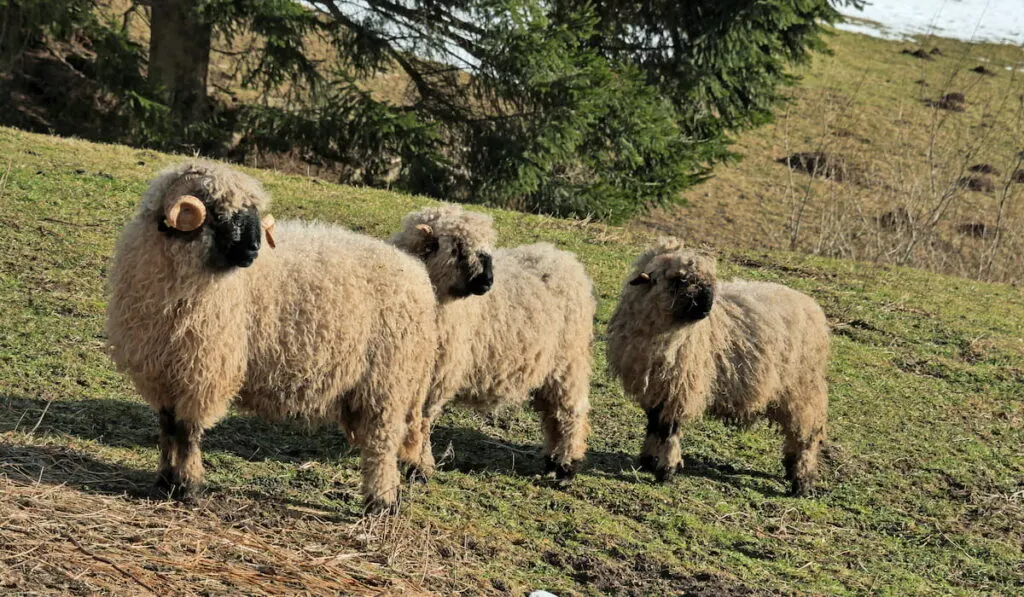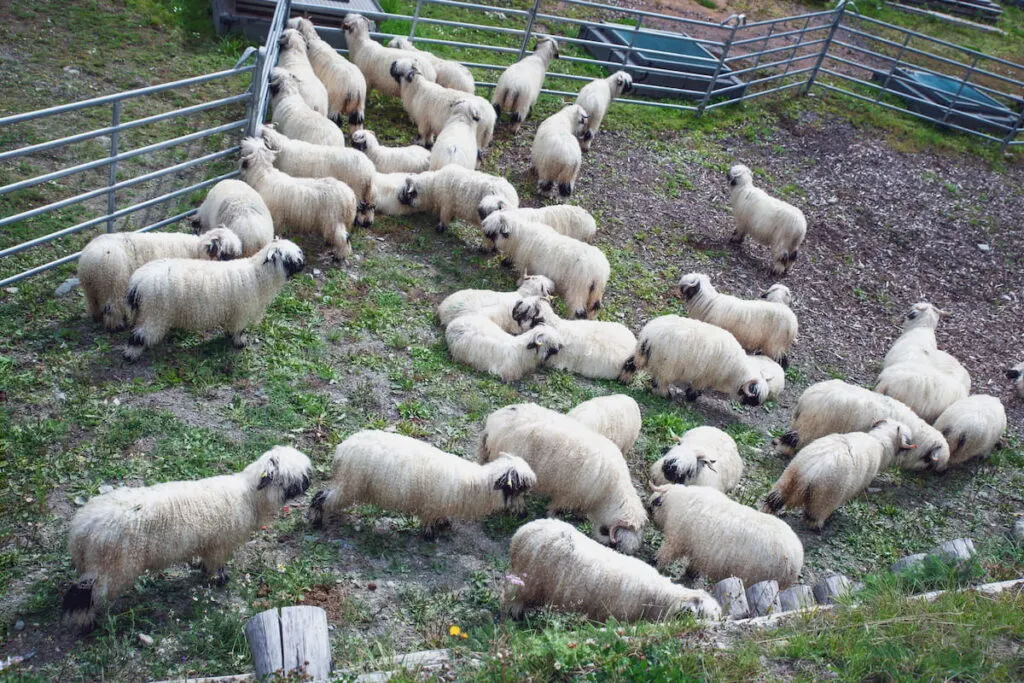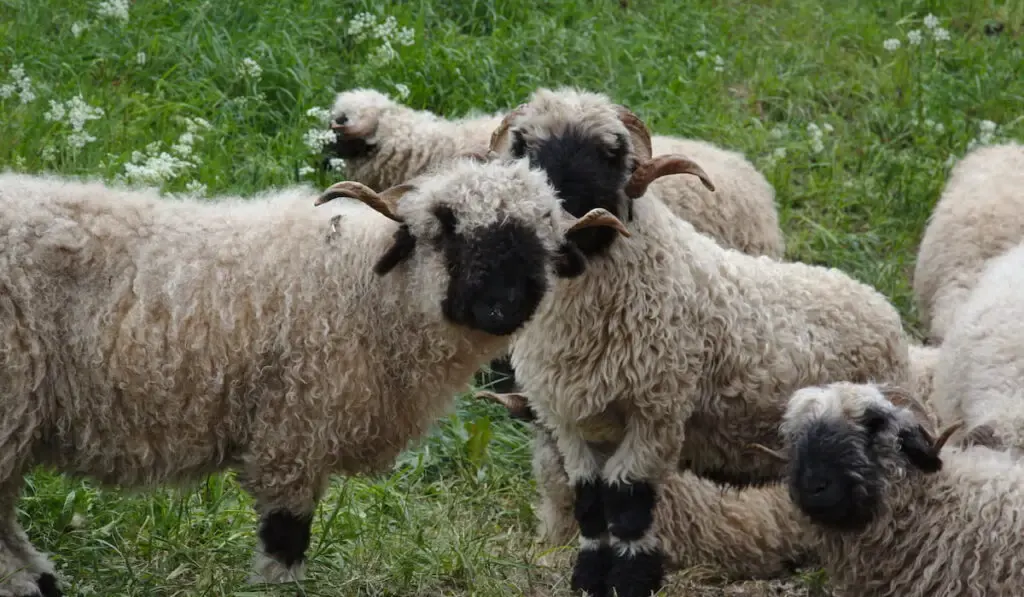When we hear about cute fluffy animals, we always think about cats, dogs, or even rabbits. It is quite uncommon to see ruminant animals like cows, goats, or even sheep that could come as cute as any domestic house pet.
But that is not the case. There is one sheep breed that is considered the world’s cutest sheep breed. They are the Valais Blacknose sheep.

The Origin of The Valais Blacknose Sheep
The Valais Blacknose sheep has its origin in the mountains of Valais in the southwestern portion of Switzerland.
This region of the Valais mountains is known as the canton of Valais, from which the name originated, and the Bernese Oberland. Also, this mountainous region is quite dry, but with a considerable amount of rain and snowfall on the mountain peaks.
In Switzerland, this sheep is also known as The Walliser Schwarznasenschaf. Their existence was first discovered around 1400. But until 1962, they were not recognized as a breed.
Throughout history, they were about to become extinct twice due to diseases, and the government pushing farmers and breeders to crossbreed these sheep for better meat production.
Characteristics Of The Valais Blacknose Sheep
This adorable sheep breed possesses a black nose, ears, eyes, ankles, knees, and hooves. Their head is short, with a wide mouth and broad forehead and a thick neck.
They also have thick and shaggy-like white coats. Every year, they can produce up to nine pounds of wool.
Male sheep of this breed weigh 176-220 lbs (80-100 kg), while females weigh between 154 and 198 lbs (70-90 kg). Valais Blacknose sheep stand between 28 and 32 inches (72 to 83 cm), which is shorter than many other sheep breeds.
Both sexes also possess spiraled horns. In some cases, random black streaks could be found on their horns.
Having a field of vision of around 300 degrees, they don’t have to turn their head just to see their rear.
Valais Blacknose sheep were raised mainly for wool production. Their thick wool could be used to produce industrial products like felts and carpets. But now, they have many purposes than just mere industrial animals.
Aside from wool, they are also being raised and bred for their meat. This makes them a dual-purpose breed. Valais Blacknose sheep possess a friendly, intelligent, calm, and docile temperament.
They are easy to handle and raise, whether for beginners or experienced breeders. They are not intimidated by human presence.
In fact, they get along with people very well. Their life expectancy is around 10 to 12 years, which gives farmers and breeders enough time to raise them properly for many purposes.
Dietary Habits And Physical Care
Like any other sheep, the Valais Blacknose diet is quite simple but healthy. They prefer a diet that consists of mountainous plants and herbs. But they also don’t mind eating grasses and small shrubs.
If possible, try to add more fodder that is rich in protein, like nuts and muesli, so they have enough energy and nutrients to grow. Also, owners and breeders should regularly change the water when feeding these sheep. Clean water is always a must.
Regular physical maintenance and care should be done to keep this sheep healthy and happy. Their hooves must be properly trimmed. Overgrown hooves can cause serious problems and lead to further pain, especially when this sheep is running or walking.
Aside from regular grooming and trimming, it is also advisable to shear their fleeces twice per year because their thickness could grow up to 12 inches.

During warmer months, Valais Blacknose sheep are prone to worm infestation like most sheep breeds. One of the easiest worm signs to watch for is a mucky rear end.
Regular inspection of their fecal matter with a microscope can be done to monitor any worm presence in their digestive system.
Fly strike may also be a problem when you see flies swarming on their body and legs. The easiest way to handle this problem is by giving afflicted sheep a regular bath and trimming, especially during warmer months.
Also, being a longwool breed, Valais Blacknose sheep are prone to certain diseases like interdigital dermatitis or ‘scald’, foot rot, and bacterial infections that generally develop around their hooves. This generally occurs due to the wet seasons and dirty environments.
To prevent these health issues from getting worse, be sure to apply blue or yellow antibiotic spray on the affected feet. This spray can be found in animal supply stores or online.
Valais Blacknose’s Bloodline Purity
Every sheep breed has its own bloodline purity level. Generally speaking, this level determines how pure one specific breed is when they are being crossed with another breed. Then, they are categorized according to their purity and how close their genetic composition to the original breed.
The higher they are placed, the purer they are. Valais Blacknose sheep could also be categorized from F1 generation to F5 generation.
For instance, the F1 generation of Valais Blacknose sheep was developed by crossing purebred registered rams with foundation ewes.
This generation carries 50 percent of Valais genes. The F2 generation is the second cross that carries 75 percent of Valais genes. After that, comes the third crosses or the F3 generation with 88 percent of Valais genes.
Then, the F4 generation is the fourth crosses that carry 94 percent of Valais genes. Finally, the final crosses are the F5 generation with the highest percentage of Valais genes of 97 percent.
The F5 generation will be produced after five consecutive breeding seasons in every session or program.
Cost And Where To Find Them
At one time, Valais Blacknose sheep were exclusive and could only be found in their native region which is Switzerland. But now, they can be found in many other countries as they are being imported and raised for domestic purposes.
In recent years, the United Kingdom, New Zealand, and Australia have imported this sheep breed for breeding programs.
But in the United States, purebred Valais Blacknose sheep are hard to find as the USDA (United States Department of Agriculture) rules do not allow the importation of embryos or live sheep.
But in the future, this might change if they allow it so more purebred Valais Blacknose sheep could be raised in the United States.
But if you are keen on purchasing these sheep, their price could vary from $1,000 to $10,000 depending on the level of bloodline purity. This doesn’t include their maintenance costs, which could be more or less the same as any other sheep.

Raising Valais Blacknose Sheep As Pets
Due to their cute and unique appearance, one might ask the million-dollar question: can Valais Blacknose sheep be adopted and raised as pets?
Yes. Valais Blacknose sheep are certainly fit to be adopted as pets. They are friendly, docile, and sociable to be around. In fact, they also don’t have any problems mixing and getting along with other farm animals.
Even in the United Kingdom, they are in high demand as pets due to their cuteness and how adorable they look. Their dog-like personality is another extra bonus point as to why raising these sheep as pets is definitely a great choice.
Final Thoughts
There is no doubt that Valais Blacknose sheep are one of the most unique sheep breeds in the world, if not the cutest sheep that has ever existed. Raising them for meat and wool or as pets can take quite a lot of work.
But as long as you know their personality, diet, and how to tend to their needs, they are like any other animal. What matters the most is your affection and care for them.
Citations
- Valais Blacknose Sheep Breed
- http://afs.okstate.edu/breeds/sheep/valaisblacknose/index.html/
- http://www.valaisblacknosesheepsociety.org/breed-standard/
- https://www.baabuk.com/blogs/stories/the-worlds-cutest-sheep-valais-blacknose
- https://attwellfarmpark.co.uk/explore/animals/valais-blacknose-sheep
- https://www.peakwildlifepark.co.uk/valais-blacknose-sheep
- https://valaisblacknosesheepcheshire.co.uk/about-the-valais-blacknose-sheep-breed/
- Valais Blacknose’s Bloodline Purity
- https://valaisblacknose.co.nz/genetics/breeding-up/
- https://www.njvalaisblacknosesheep.com/buy-valais-blacknose-sheep
